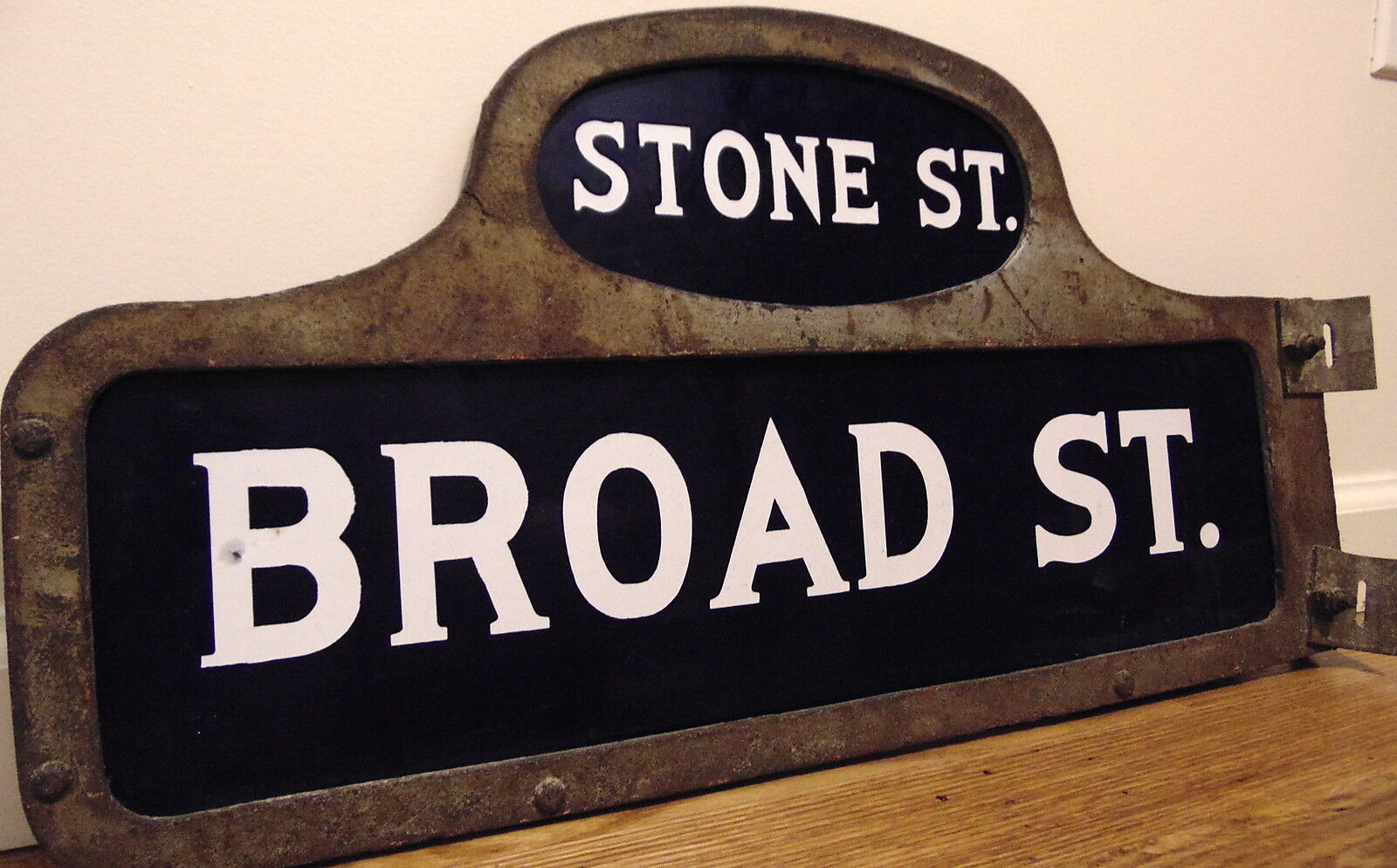 On eBay Now...
On eBay Now...New York Stock Exchange Curb Market Broker NYSE Wall BROAD STREET Porcelain Sign For Sale

When you click on links to various merchants on this site and make a purchase, this can result in this site earning a commission. Affiliate programs and affiliations include, but are not limited to, the eBay Partner Network.
New York Stock Exchange Curb Market Broker NYSE Wall BROAD STREET Porcelain Sign:
$79000.00
Take look through my other items as I have just listed two other exceedingly rarecirca1916 Wall Street early porcelain street signs! You will never find another collection of Wall Street financial history as Icurrently have listed!!!
Make an offer...Up for sale is the exceedingly rare and historic original 1920\'s porcelain enamel NYC street sign which marked the corner of Broad Street& Stone Street, the heart of the historic Curb Stone brokers, the roots of the NYSE and the origins of the American Stock Exchange.As almost none of these early signs have survived this is almost certainly a one of a kind item. This historic sign is made of porcelain enamel over steel and is still in its original heavy cast iron street sign frame. As this sign dates to the early 1920\'s, it was likely standing on the day of thehistoric stock market crash of October 29, 1929.
As a former Merrill Lynch broker I have been collecting antique Wall Street memorabilia for about thirty five years. This is by far my most interesting and rare item. This amazing piece of American financial historymeasures24.25\"wide, 12.5\" tall and 1\" thick. The overallcondition is extraordinaryespecially considering that it is approximately 95 years old. I have never attempted to clean or polish the sign. I have chosen to keep it completely original with all of its age and character still intact.The signis cobalt blue with white-beige lettering. It is free of chips to the porcelain and the enamel still retains a beautiful gloss. The original street sign frame is made of cast iron and has a beautifully weathered steel tone. The overall condition is remarkable.
This museum worthy item spent its life on Broad Street likely sometime beginning in the 1920\'s overlooking much of the most significant financial history of this country. I havebeen able to find a photograph of the sign at the corner of Wall Street & New Streettaken on October 29, 1929 during the famed stock market crash,I\'ve included itbelow.If anyone out there has any early photographs showing the corner of Broad Street & Stone Street with a view of this sign, I would greatly appreciate it if they would email me.
Some historical information... Wall Street can trace its beginnings to 1788 when the sale of an $80 million dollar bond issue was authorized by the first Congress of the United States. Four years later in 1792 brokers established the first stock exchange to sell debt which was used to finance the Revolutionary War. These first stockbrokers conducted business outdoors under a large buttonwood tree which stood between 78 & 80 Wall Street. They soon drew up an agreement establishing rules and regulations for trading called the Buttonwood Agreement.
Many of those brokers then moved indoors and established the New York Stock Exchange, however most brokers did not want to be bound by rules and regulations so they remained outdoors. This large group of very noisy, unregulated, unscrupulous swindlers became known as curb stone brokers. They peddled mostly worthless stocks and unwary buyers were bilked in what became known as The New York Curb Stone Market. This wild unregulated market mostly sold very risky speculative stocks in industries such as the early railroads and oil companies. Some of the money raised in these unregulated and questionable markets did in fact help to fuel the growth of some of Americas early industries.
In 1873, Emanuel Mendels a successful curb stone broker who was known as \"the father of the curb\", was the driving force behind the first efforts to organize and regulate the curb market. He drew up an agreement establishing rules which eventually became The New York Curb Market. They moved their operations to Broad Street but remained outdoors. The scene was so wild that it quickly became a tourist attraction as people would come to witness what appeared to be a large undisciplined mob of brokers screaming and waving signals to clerks hanging from the windows of offices all along Broad Street. However this market was still viewed with disdain by the NY Stock Exchange traders as unregulated and unscrupulous.
By 1920 this market was out of control and on January 6, 1920 the District Attorney Edwin Kilroe urged the licensing of these brokers and called for government control of the market calling the curb stone brokers \"a public nuisance\". Some members recognized that a move to a permanent indoor headquarters would result in respectability but most felt that the curb market was a cherished tradition and they refused to move off Broad Street. Pressure was put on these brokers by powerful NY Stock Exchange members including JP Morgan and The Curb Stone Market eventually moved indoors. The NY Times wrote, \"while this change will rob the city of one of its picturesque features, there is no doubt of its desirability\".
On June 25, 1921 the Curb Stone brokers held their last outdoor session on Broad Street. The following Monday an impressive ceremony opened the new New York Curb Stone Market. The New York Tribune\'s front page headline was \"The Curb is Dead!\" Change came again in 1953 when the New York Curb Market changed its name to... The American Stock Exchange. In 2008, The American Stock Exchange was taken over by the parent company of the NYSE.
Perhaps one of the most significant pieces of American financial history, this incredible item should be on display in the corporate offices of a major financial firm or ondisplay in a museum.
